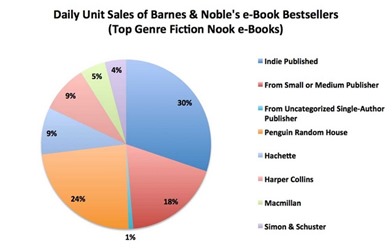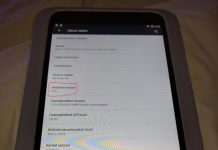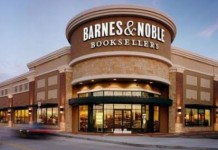 Hugh Howey and his stats guy have again crawled, this time looking at one day’s worth of Barnes & Noble sales data for the top 5,000 genre fiction Nook e-books. They found a picture similar to their Amazon look, though a bit less skewed in favor of self-publishing. (Perhaps this is because B&N doesn’t have as good a self-publishing program as Amazon? Or because Amazon offers incentive to people to self-publish with Amazon exclusively so more of them do? Howey doesn’t speculate.)
Hugh Howey and his stats guy have again crawled, this time looking at one day’s worth of Barnes & Noble sales data for the top 5,000 genre fiction Nook e-books. They found a picture similar to their Amazon look, though a bit less skewed in favor of self-publishing. (Perhaps this is because B&N doesn’t have as good a self-publishing program as Amazon? Or because Amazon offers incentive to people to self-publish with Amazon exclusively so more of them do? Howey doesn’t speculate.)
Even with this being said, indie-published titles make up over half of the top 5,000 titles, with small or medium publishers taking 21% and the Big Five taking 26%. In daily unit sales, the Big Five make up fully half, with indie accounting for 30% and small or medium publishers 19%. (Howey then breaks this down by individual Big Five, just so he can show indie-published books account for more than the single biggest Big Five publisher still.)
Further on, he does his stats magic to indicate that revenue to authors from indie- and small or medium publishers make up almost as much put together as Big Five authors get. This is probably the weakest part of the presentation for purposes of showing how authors do, because the Big Five is clearly coming out ahead here. (He goes ahead and breaks the Big Five score down by individual publisher here, too.)
But again, given that B&N is not as popular a self-publishing destination as Amazon, that is rather to be expected. He really doesn’t need to break the revenue (and for that matter market share) down by individual publisher. He didn’t do it on either of the two prior reports, where self-publishing had the better numbers, and it just ends up making it look like he’s trying to massage the figures so they look more favorable. Hugh, when the Big Five do have better numbers, you should just let it be. You really don’t need to try to prove anything, it just weakens your position.
Update: Howey has said elsewhere that he just started breaking the numbers out now because he’d been asked to. I still think it looks a bit odd to start doing it right when he needed to be able to say that self-publishing had bigger numbers than something, but I guess coincidences do happen.
That being said, he is willing to admit when earlier guesses were wrong. In reference to his earlier correlation of highest star ratings to lowest average price, Howey had guessed that customers might be more inclined to rate cheaper books higher because they felt less like they’d overpaid for them. However, Howey notes:
Our initial speculation about price correlating to average review score has since been disproven by others, who looked at our data more closely. We may be left with the conclusion that self-published works are outselling every other publisher by dint of readers simply liking them better.
In the end, the numbers are pretty much in line with what I would expect, given B&N’s weaker self-publishing program and Amazon’s strong incentives for exclusivity. In fact, it’s pretty impressive that the self-publishing figures for B&N are as good as they are. But given B&N’s paltry market share compared to Amazon’s, it really might not matter that much in the long run. No matter the relative size of the slices, Amazon has a much bigger pie.
Some of the commenters also note some seeming hanky-panky in the bestseller lists when it comes to erotica—manually adding ranks to erotic books to keep them out of the top 100. If this is true, it’s a serious problem for B&N’s credibility.
































